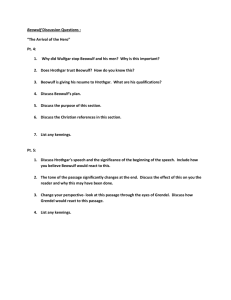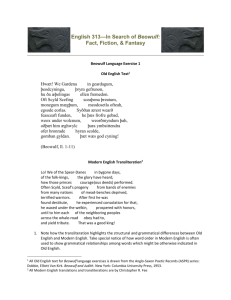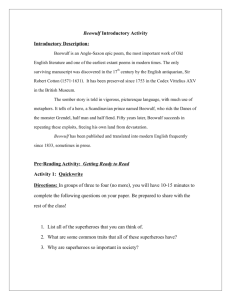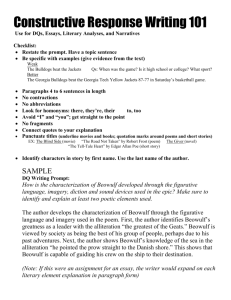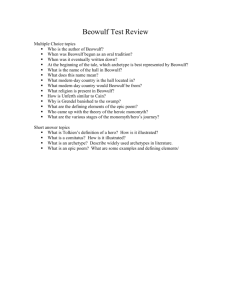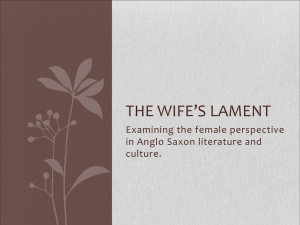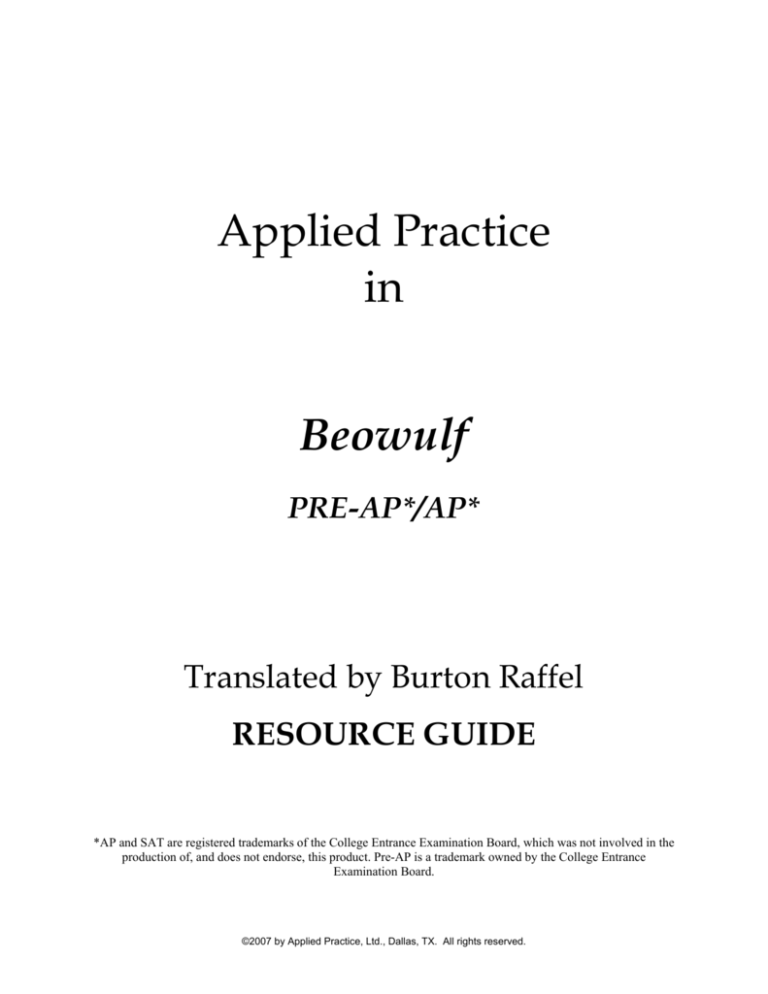
Applied Practice
in
Beowulf
PRE-AP*/AP*
Translated by Burton Raffel
RESOURCE GUIDE
*AP and SAT are registered trademarks of the College Entrance Examination Board, which was not involved in the
production of, and does not endorse, this product. Pre-AP is a trademark owned by the College Entrance
Examination Board.
©2007 by Applied Practice, Ltd., Dallas, TX. All rights reserved.
APPLIED PRACTICE
Resource Guide
Beowulf
Pre-AP*/AP* Version
Teacher Notes
A Note for Teachers .............................................................. 5
A Note About Format............................................................ 7
Teaching Resources
Strategies for Multiple-Choice Questions............................11
Strategies for Free-Response Questions ..............................12
Glossary of Literary Terms ..................................................13
Vocabulary Lists by Passage................................................21
Student Practices
Multiple-Choice Questions ..................................................27
Free-Response Questions .....................................................43
Answer Key and Explanations
Multiple-Choice Answer Key ..............................................53
Multiple-Choice Answer Explanations................................57
Free-Response Scoring Guide..............................................85
*Pre-AP and AP are registered trademarks of the College Entrance Examination Board, which was not involved in the production of,
and does not endorse, this product.
©2007 by Applied Practice, Ltd., Dallas, TX. All rights reserved.
GLOSSARY OF LITERARY TERMS
absolute—a word free from limitations or qualifications (“best,” “all,” “unique,”
“perfect”)
adage—a familiar proverb or wise saying
ad hominem argument—an argument attacking an individual’s character rather than his
or her position on an issue
allegory—a literary work in which characters, objects, or actions represent abstractions
alliteration—the repetition of initial sounds in successive or neighboring words
allusion—a reference to something literary, mythological, or historical that the author
assumes the reader will recognize
analogy—a comparison of two different things that are similar in some way
anaphora—the repetition of words or phrases at the beginning of consecutive lines or
sentences
anecdote—a brief narrative that focuses on a particular incident or event
antecedent—the word, phrase, or clause to which a pronoun refers
antithesis—a statement in which two opposing ideas are balanced
aphorism—a concise statement that expresses succinctly a general truth or idea, often
using rhyme or balance
apostrophe—a figure of speech in which one directly addresses an absent or imaginary
person, or some abstraction
archetype—a detail, image, or character type that occurs frequently in literature and myth
and is thought to appeal in a universal way to the unconscious and to evoke a
response
argument—a statement of the meaning or main point of a literary work
asyndeton—a construction in which elements are presented in a series without
conjunctions
©2007 by Applied Practice, Ltd., Dallas, TX. All rights reserved.
13
VOCABULARY LIST FOR BEOWULF
Note: Vocabulary from the literary passage is listed first, followed by vocabulary from the
questions and answers.
Passage 1
Passage 2
Passage 3
tribute
mail
spoils
gabled
spawned
brood
lair
laments
reparation
plundering
heathen
solace
________
prow
sentinels
smith
mead
linden
________
furrows
reprisal
afflicted
________
meticulousness
dispassionate
fawning
laudatory
elegiac
pedantic
obsequious
maudlin
rash
arduous
impudent
discursive
didactic
anecdotal
expository
terse
groveling
strident
magnanimous
diffident
concession
rebuttal
equivocation
exposition
digression
©2007 by Applied Practice, Ltd., Dallas, TX. All rights reserved.
21
Directions: This part consists of selections from Beowulf and questions on their content, form, and style.
After reading a passage, choose the best answer to each question.
Note: Pay particular attention to the requirement of questions that contain the word NOT, LEAST, or
EXCEPT.
Passage 1, Questions 1-8. Read the prologue and sections 1 and 2, beginning “Hear me!” and ending “and
seek our Father’s peace” (pages 23-29) carefully before you choose your answers.
1.
The primary effect of the details presented
in the prologue (lines 1-52) is to
4.
(A) demonstrate Shild’s uniqueness as a
ruler
(B) suggest that Beo would be a greater
leader than his father
(C) create a sense of suspense in the poet’s
audience
(D) provide insight into the values of a
culture
(E) show the objectivity and meticulousness
of the poet
2.
I. is inevitable
II. affords opportunities to win
glory
III. is not governed by codes or
rules
(A)
(B)
(C)
(D)
(E)
5.
dispassionate to emotional
fawning to realistic
laudatory to elegiac
pedantic to obsequious
exuberant to maudlin
Hrothgar’s building the hall primarily
reflects his
(A)
(B)
(C)
(D)
(E)
desire for personal glory
insistence on absolute obedience
determination to be invulnerable
prideful quest to reach Heaven
generosity to his followers
A controlling rhetorical device in the
prologue is
6.
(A)
(B)
(C)
(D)
(E)
metaphor
alliteration
personification
apostrophe
simile
In lines 86-114 (“A powerful monster . . .
again defeated”), Grendel is characterized as
all of the following EXCEPT
(A)
(B)
(C)
(D)
(E)
7.
persecuted
envious
dangerous
rebellious
bitter
The description of Grendel’s tyranny, as
“sung in all Men’s ears” by poets across the
seas, is developed primarily by the use of
(A)
(B)
(C)
(D)
(E)
28
II only
III only
I and II only
II and III only
I, II, and III
The tone of the prologue progresses from
(A)
(B)
(C)
(D)
(E)
3.
Lines 53-85 (“Then Beo was king . . . Herot
to burn”) suggest that war
Biblical allusions
parallel structure
understatement
foreshadowing
hyperbole
©2007 by Applied Practice, Ltd., Dallas, TX. All rights reserved.
Question 2
(Suggested time—40 minutes)
In the final line of the Burton Raffel translation of Beowulf used for this resource guide, Beowulf is
described as “deserving of praise.” However, in many other translations, the final phrase refers not to
Beowulf’s meriting praise, but to his desiring, or seeking, it (“desirous of praise,” “keenest for praise,”
“fondest of honor”). In a well-organized essay, discuss the significance of the differing characterizations of
Beowulf and, based on your reading of the entire poem, explain which characterization (Beowulf as
deserving praise versus Beowulf desiring and seeking praise or honor) is most consistent with the title hero.
Use specific examples from Beowulf to support your points.
©2007 by Applied Practice, Ltd., Dallas, TX. All rights reserved.
45


